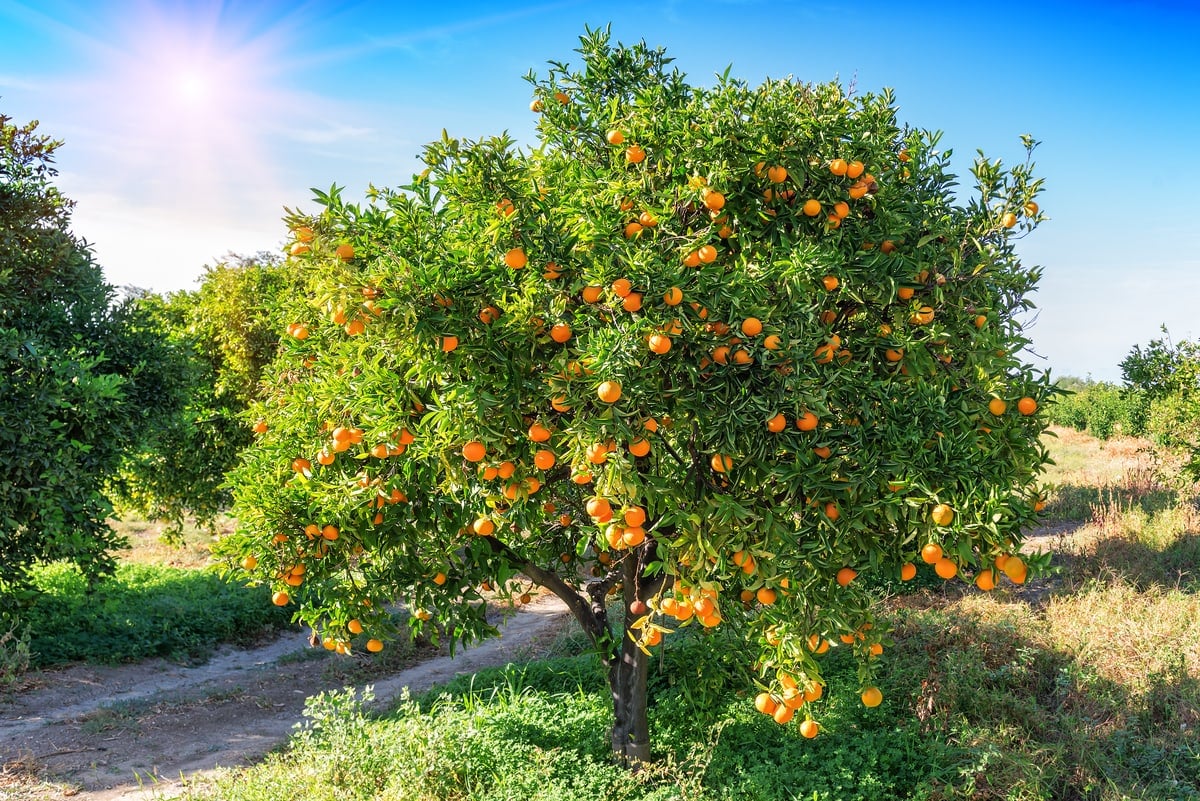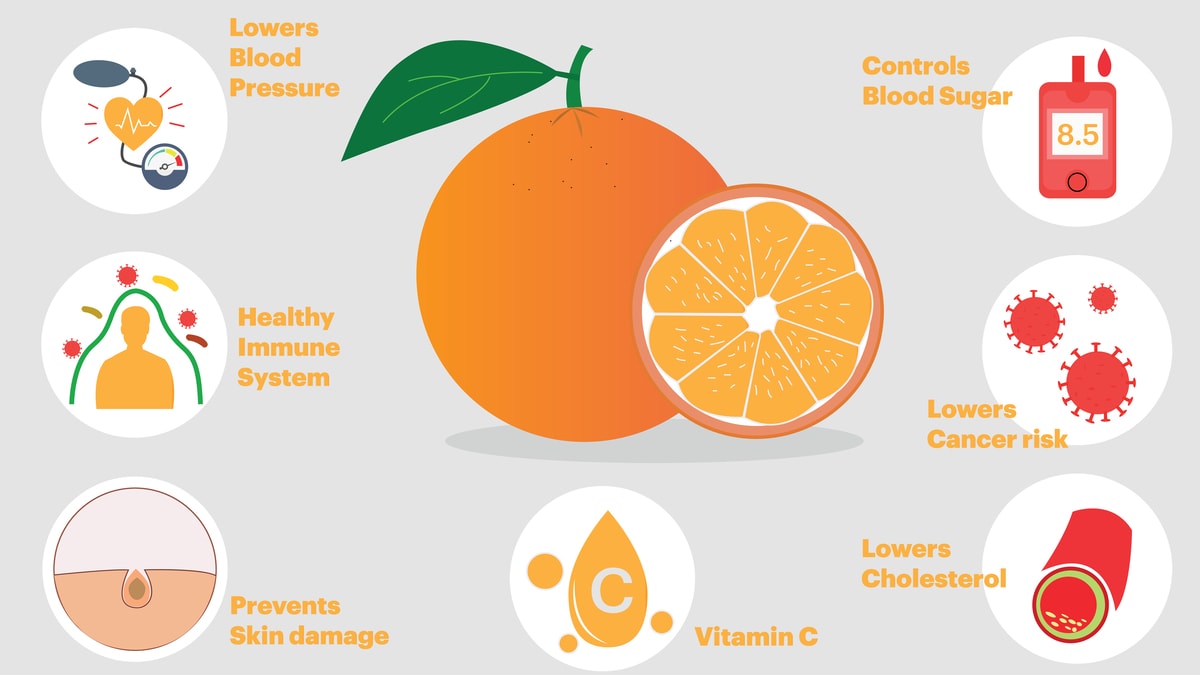Oranges, one of the most popular fruits today, are a low-calorie and highly nutritious addition to one’s diet.

Oranges not only provide vitamins, minerals, and other essential nutrients, but also offer many other health benefits. Consuming oranges can protect cells from damage, help the body produce collagen, prevent anemia, boost the immune system, and also slow down age-related macular degeneration (AMD).
In this article, we will take a look at everything one needs to know about oranges. We will look at where the fruit originated, what different types and varieties of oranges are there, how and where the fruit grows, its nutritional values, health benefits, as well as its health risks. Lastly, we will also look at some of the ways you can add oranges to your diet, including by juicing and blending.
Table of Contents
A Brief History of Oranges
Oranges originated in Asia, with most written records pointing to China. The first written evidence of the citrus fruit places it in China in the year 314. From there, early civilizations brought oranges to India and to the east coast of Africa. 400 years later, the Moors brought the fruit from China and introduced oranges to the Mediterranean region. Although the fruit became well-known at this time, it was only the sour or bitter orange type.
In the late 16th century, Italian and Portuguese merchants brought orange trees to the Mediterranean area, consequently introducing the sweet orange. Shortly after, the sweet orange became a popular edible fruit, albeit mostly enjoyed only by the affluent. By the year 1646, the sweet orange was well-known throughout Europe. In fact, the wealthy even had orange trees grown in private orange groves, which they called orangeries. Later on, Spanish travelers introduced sweet oranges to America.
Types of Oranges
Experts categorize oranges into two types: sweet oranges (Citrus sinensis) and bitter oranges (Citrus aurantium). Furthermore, each type has numerous varieties, with each having different characteristics. In fact, the orange has over 600 varieties.
Sweet Orange
Gardeners say that sweet orange has four classes, known as the common orange, blood orange, navel orange, and acidless orange. Also, under each class, numerous varieties exist. Each orange variety differs in how they look and taste, with some of the varieties even containing no seeds.
Common Orange
Health enthusiasts often prefer common oranges for their juice. This variety is widely grown worldwide, hence the name. As one of the most popular fruits since the early civilizations, many varieties exist under the common orange. The most widely grown out of all these varieties include:
- Valencia, commonly used for juicing and eating raw. Valencia oranges contain a ton of juice, which makes them perfect for freshly squeezed orange juice.
- Hamlin, this variety yields a lot of yellow-colored juice. The fruit itself may either be seedless or may have some small seeds.
Blood Orange
Also known as pigmented orange, this variety has two types: light blood orange and deep blood orange. Blood oranges stand out from other types because of their deep red hue. But contrary to what one would think, blood oranges naturally mutated from sweet oranges. A high amount of anthocyanin gives blood oranges their deep red color.
This variety, like common oranges, contains a lot of juice. However, blood oranges have a unique sweet and tart flavor. The flavor of the three main types—Moro, Sanguinello, and Tarocco—ranges from tart to sweet, respectively. They can be eaten raw, juiced, or made into marmalade. Also, they make a great addition to desserts and sauces.

Navel Orange
The navel orange has a bottom that resembles a human navel, hence the name. One of the most popular kinds of oranges, many health enthusiasts prefer navel oranges for their high vitamin C content, low acid content, and exquisite sweetness. Aside from those, others also value navel oranges because they are packed with sweet juice, seedless, and easy to peel.
Furthermore, all of these characteristics combined make navel oranges great for eating raw or adding to salads. They also result in delicious orange juice that’s neither too sweet nor too bitter. However, juicing enthusiasts warn that the extracted orange juice should be consumed immediately as the taste may deteriorate. And, to minimize waste, the leftover zest can be used in baking for added flavor.
Acidless Orange
Just like the navel orange, acidless oranges contain very little acid. However, the low acid content results in most acidless orange varieties having little flavor. Because of this, acidless oranges are typically eaten raw and not juiced. Still, experts classify acid-less oranges under “sweet” oranges, as some varieties contain sweet juice. Some varieties include the lima orange and the meski orange.
Although most have little flavor, some juicing enthusiasts juice some acidless orange varieties, such as the Vaniglia Sanguigno. They typically combine the extracted juice with another fruit’s juice, which they say results in a juice that tastes better than any store-bought juice.
Bitter Orange
Because the fruit is so sour and bitter, bitter oranges (also known as the "sour orange") are rarely eaten. Some use the bitter orange’s dried peel as a seasoning, while experts often use bitter oranges to make medicine. Most of the fruit is used in making medicine—from the rind to the orange blossom, leaf, fruit, and fruit juice. Others make essential oils from bitter oranges, which has a wide range of uses—from adding flavor in cooking to treating fungal skin infections.
Additionally, experts believe that the bitter orange has a variety of health benefits. Some use bitter oranges to improve appetite, while others use the fruit to combat obesity and for weight loss. Other experts use the fruit to combat indigestion (dyspepsia), upset stomachs, nasal congestion, chronic fatigue syndrome (CFS), and many other conditions. A few common varieties of bitter oranges include:
- Seville orange is often used as rootstock for the sweet orange tree and in the making of marmalade.
- Bergamot orange, grown primarily for its peel, is often used in perfumes and for flavoring Earl Grey tea.
- Trifoliate orange is also used as rootstock for sweet orange trees and making marmalade.
Mandarin Orange
Some people prefer mandarin oranges over regular oranges as they are smaller in size, have looser skins that are easier to peel, and offer a sweeter taste with less acidity. Commonly known as simply mandarins, people often eat these fruits as snacks or add them to salads as they are practically seedless. Because of this, many dessert recipes also have mandarins listed as an ingredient.
Under mandarins, many varieties have become popular over the years. This includes satsuma, but the two most popular varieties are tangerines and clementines. Both varieties have their own characteristics and offer unique flavors.
Tangerines
Some people prefer the tangerine as it is small, easy to peel, and sweeter than typical oranges. These characteristics make them great for juicing, snacking, baking, and adding to salads. And they also contain more vitamin C, which makes them a great choice for those looking to add more of the vitamin into their diets. Some health enthusiasts prefer Honeybell oranges, a hybrid of the Darcy Tangerine and the Duncan Grapefruit.
Clementines
While some prefer tangerines over typical oranges, others favor clementines because they are seedless. Just like tangerines, clementines also come in smaller sizes and easy-to-peel skins. This makes them great for baking, adding to salads, or snacking on raw. They also offer a unique taste—a honey-like sweetness with low acid content—that often makes them a favorite among children.

Planting and Growing Oranges
Typically, winter brings in the cold, that makes it difficult for trees and fields to bear a rich harvest. However, oranges remain one of the exceptions, as they often taste best when harvested during the winter months.
Unlike other fruits, oranges and other citrus fruits do not ripen once picked. Because of this, those who grow oranges only pick them from the trees when they are fully ripe. And, like other citrus trees, orange trees thrive when planted in sunny and wind-protected areas.
Gardeners regard Florida and California as great locations to grow orange trees. In fact, Florida citrus and California oranges are known as some of the best. These citrus fruits include grapefruits and tangerines. In particular, their fresh oranges are typically flavorful and extremely juicy.
Once you have an orange tree planted, you will need to know how much water it needs. Orange trees grown in different areas need different amounts of water, as the climate and the amount of rainfall it enjoys can vary. However, gardeners advise regularly watering orange trees in the spring and withholding irrigation in the fall. Keep in mind that the more water an orange tree receives, the lower the solid content of the citrus fruit. Still, make sure not to overdo it—about 1 to 1 and a half-inch of water per week should be enough.
Additionally, citrus trees do not need fruit thinning, unlike other fruit trees. They usually go through a “June drop,” wherein they naturally drop some of their immature fruit. You also do not need to prune orange trees for shape but make sure to remove any branches found near the ground, up to a foot high. In addition, you should also remove all damaged or dying branches as soon as you notice them.
Harvesting Oranges
Typically, you can expect the oranges to ripen after 6 to 8 months, depending on the climate. Gardeners say that the best indicator of ripeness is taste, but remember that citrus fruits do not ripen once picked, so make sure not to pick the oranges too early. A rich skin color usually signifies that the oranges are ripe for picking.

To harvest oranges, cut the fruits off using pruning shears or simply pull the fruit stalk off from the tree. You can store oranges at room temperature for about a week, as long as they are out of direct sunlight. But, if you know that you will not be eating them any time soon, you should keep them in your refrigerator’s crisper drawer, where they can last for a few weeks.
Why are oranges considered a superfood?
Sweet, juicy oranges make for healthy, delicious snacks and serve as great additions to salads or ingredients in various recipes. Although most people know that oranges are an excellent source of vitamin C, that is not all they offer. In fact, oranges also contain calcium, potassium, fiber, folate, and high amounts of B vitamins.
Nutritional Values
According to the United States Department of Agriculture (USDA), 100 grams (3.5 oz) of all commercial varieties of raw orange contains the following:
- Energy: 47 kcal (197 kJ)
- Carbohydrates: 11.75 grams
- Sugars: 9.35 grams
- Soluble fiber: 2.4 grams
- Fat: 0.12 grams
- Protein: 0.94 grams
- Water: 86.75 grams

In terms of vitamins, the same 100 grams of raw orange contains:
- Vitamin A: 11 μg; 1% of the recommended daily value (%DV)
- Thiamine (Vitamin B1): 0.087 mg; 8 %DV
- Riboflavin (Vitamin B2): 0.04 mg; 3 %DV
- Niacin (Vitamin B3): 0.282 mg; 2 %DV
- Pantothenic acid (Vitamin B5): 0.25 mg; 5 %DV
- Vitamin B6: 0.06 mg; 5 %DV
- Folate (Vitamin B9): 30 μg; 8 %DV
- Choline: 8.4 mg; 2 %DV
- Vitamin C: 53.2 mg; 64 %DV
- Vitamin E: 0.18 mg; 1 %DV
And, the same 100 grams of raw orange contains the following minerals:
- Calcium: 40 mg; 4 %DV
- Iron: 0.1 mg; 1 %DV
- Magnesium: 10 mg; 3 %DV
- Manganese: 0.025 mg; 1 %DV
- Phosphorus: 14 mg; 2 %DV
- Potassium: 181 mg; 4 %DV
- Zinc: 0.07 mg; 1 %DV
Sweet oranges have been a popular snack since the early civilizations as they are delicious and nutritious. After all, not many foods can claim the same. In fact, a whole medium orange contains just about 60 calories, and it has zero fat, cholesterol, and sodium. The same orange offers about 70 mg of vitamin C, 3 grams of fiber, 12 grams of sugar, 1 gram of protein, 15.4 grams of carbohydrates, and about 6% of the average adult’s daily recommended amount of calcium.
Health Benefits
Aside from the many vitamins, minerals, citrus flavonoids, citrus limonoids, and beneficial nutrients that they contain, oranges also offer many health benefits. These numerous benefits include the following:
Promotes Heart Health
As we learned, oranges also contain fiber, potassium, and choline. All of these minerals work together to improve one’s heart health. In fact, a 2017 review shows that consuming enough fiber can lower the risk of developing heart disease or reduce the risk of it becoming fatal. According to the review, the fruit’s ability to lower cholesterol levels in the blood makes this possible. Furthermore, the citrus flavonoid gives oranges a powerful anti-inflammatory property that reduces the risk of chronic inflammation, further lowering the risk of certain chronic diseases.
Additionally, a cup of orange juice contains about 14% of the average adult’s daily potassium requirement. And, experts have found that people with higher potassium intakes are at a lower risk of stroke and other cardiovascular diseases. Furthermore, another clinical study has shown that daily intake of orange juice for four weeks produced a blood-thinning effect, significantly lowering the participants’ blood pressure levels. Finally, aside from those, oranges contain phytonutrients that can also lower the risk of developing cardiovascular disease.
Boosts the Immune System and Offers Antioxidant Properties
Citrus fruits naturally contain high amounts of vitamin C, and oranges have even higher amounts than other citrus fruits. And, experts have long spoken of the many health benefits that vitamin C provides. Well-known as a powerful antioxidant, vitamin C plays an important role in protecting cells from damage, aids in repairing cells, and also in healing wounds.

Additionally, a 2018 review published in the journal Advances in Analytical and Pharmaceutical Chemistry says that vitamin C neutralizes and inhibits the formation of harmful free radicals. Various factors can lead to the formation of free radicals, such as environmental pollution, stress, and cigarette smoke. Being exposed to high levels of free radicals can lead to chronic diseases such as cancer and heart disease, which explains how important the role that vitamin C plays.
Furthermore, vitamin C also boosts a person’s immune system. It raises people’s immunity against common viruses and viral infections, such as the common cold.
Lowers the Risk of Developing Anemia
Iron deficiency often leads to a condition known as anemia. People with anemia often have low levels of red blood cells or hemoglobin, which decreases the amount of oxygen that the various parts of their bodies receive. Oranges may not be a good source of iron, but they contain high amounts of naturally occurring acids such as citric acid and ascorbic acid (vitamin C). According to a study from the British Journal of Nutrition, both of these acids can increase the body’s absorption of iron from the digestive tract. Thus, oranges may help prevent anemia when eaten with iron-rich food.
Reduces the Risk of Diabetes
The American Diabetes Association (ADA) recommends consuming oranges for people with diabetes. In fact, the ADA considers oranges and other citrus fruits a “superfood” for people with diabetes. Indeed, the fiber that the citrus fruit contains has positive effects for both type 1 and type 2 diabetes. For those with type 1 diabetes, fiber may help lower their blood sugar levels, while it may improve blood sugar, lipid, and insulin levels in people with type 2 diabetes.
In addition, fiber also helps with weight loss. Because the body processes fiber more slowly than other nutrients, it helps keep one feel full for longer. In doing so, it also reduces one’s urge to eat snacks throughout the day. Obese and overweight people have a higher risk of developing type 2 diabetes. Thus, a diet rich in fiber can keep blood sugar levels normal and also help prevent type 2 diabetes by keeping one’s weight regular. Of course, one should not only eat oranges but follow a balanced diet rich in fruits and vegetables.
Keeps the Skin Healthy
Furthermore, vitamin C helps in the production of the proteins that keep our skin healthy. It aids in the production of collagen, which supports skin health, promotes wound healing, and improves the skin’s strength. In fact, a 2015 review suggested that a diet rich in vitamin C improved the participants’ skin health and appearance. It reduced facial wrinkling, kept skin elastic, reduced roughness, and lessened skin discoloration.
Helps Prevent Birth Defects
Another B vitamin that oranges contain, folate plays an important role in fetal development. Folate can prevent neural tube defects, which are birth defects of the brain, spine, or spinal cord. Thus, for women of birth-giving age, an adequate intake of the vitamin becomes especially vital.

Can you consume too much orange?
Oranges may offer numerous health benefits, but consuming too much of the citrus fruit can lead to the following side effects:
- Consuming too much fiber can affect digestion, leading to abdominal cramps, constipation, or even diarrhea.
- Although oranges do not contain a high amount of calories, eating several of the fruit per day can lead to weight gain.
- While vitamin C may be good for the body, consuming more than 2,000 milligrams per day can lead to diarrhea, nausea, vomiting, heartburn, bloating, cramps, headaches, and insomnia.
- Oranges contain citric acid and ascorbic acid, so consuming too much of the fruit can result in high acidity which can lead to or worsen heartburn.
- Those who suffer from gastroesophageal reflux disease (GERD) or acid reflux disease should be careful not to consume too many oranges. Doing so can lead to symptoms such as heartburn and regurgitation worsening.
- Lastly, the American Heart Association warns that people who take beta-blockers should be careful not to consume too many oranges, which are rich in potassium. This could end up in too much potassium intake, which could lead to kidney stone formation and kidney damage.
Although oranges may offer many health benefits, remember that they can only be enjoyed when consuming oranges responsibly. So, make sure to consult your doctor before making any changes to your diet.
Adding Oranges To Your Diet
Now that we know how oranges can make a healthy diet even better, you may want to know how you can start adding the fruit to your diet. Oranges thrive in the winter months, so oranges can be your go-to fruit if you usually find it difficult to buy ripe fruits and veggies during winter. Adding oranges to your diet does not have to be difficult at all; in fact, you can do so by doing any of the following:
- Simply snack on the fresh fruit raw.
- Make a fruit salad including oranges.
- Add some of the orange peel to a recipe when baking.
- Add some orange slices when cooking lunch or dinner.
- Make homemade juice.
- Use oranges as a garnish.
- Use orange juice to make low-calorie, flavorful sauces and marinades.
However, keep in mind that you should keep the fruit in the fridge once peeled. If you wrap orange slices tightly or keep them in an airtight container, they can last for about three to four days.
Juicing Oranges
Some people like eating oranges raw, using them to cook, and making various recipes, but others also like to consume them juiced. In fact, about 85 percent of all oranges produced worldwide are used to make orange juice. On top of the health benefits that oranges provide, juicing also offers various benefits of its own. For example, many people prefer drinking freshly squeezed orange juice over water as it can keep them hydrated while providing a delicious burst of flavor.

If you often find yourself drinking less than the recommended eight 8-ounce glasses of water per day, consider juicing oranges in addition to eating the fruit. After all, the juice extracted from oranges contains most of the fruit’s vitamins, minerals, and essential nutrients. And, aside from keeping people hydrated, several studies have also shown that juicing makes it easier for the body to absorb nutrients, gives the digestive system a short break from digesting fiber, aids digestion, promotes weight loss, and reduces the risk of developing some chronic conditions, including cancer.
However, make sure to keep track of how much orange juice you consume as drinking too much can add excess calories and sugar to your diet. Experts warn that this can lead to blood sugar levels spiking, so those with diabetes should take extra care. Because of this, many experts advise mainly juicing vegetables and adding a few slices of fruit to add some sweetness. Furthermore, juicing causes the naturally occurring fiber to get lost in the process. This may be good for those who suffer from bloating and constipation, but it may be a downside for those who need more fiber. In that case, blending may be a better alternative.
Sample Orange Juice Recipes
If you have decided to try juicing after consulting your doctor, you might need a little guidance when you start. To help you out, here we recommend some of the best orange juice recipes we could find:
- Homemade Fresh Orange Juice Recipe
- Green Vitamin Juice Recipe
- Immune Boosting Orange, Carrot & Ginger Juice Recipe
Blending Oranges
Another healthy alternative to juicing, blending oranges can be a great way to add oranges to your diet. Just like drinking juice, blending also keeps you hydrated while providing flavor. And, blending also offers several benefits. Juicing can take a while depending on the kind of juicer you have, but blending almost always takes less time. No matter what kind of blender and ingredients you use, blending will often take just a few minutes. For busy individuals, the convenience this offers is often a deciding factor.
Aside from taking less time, blending also retains the fiber in the smoothie or shake. Because of this alone, many health experts recommend blending over juicing. Smoothies and shakes can serve as a healthy, convenient meal on the go for busy individuals as it contains fiber, which helps make one feel full longer. Furthermore, the shakes and smoothies also contain all the nutrients from the ingredients, resulting in a boost to the immune system, a reduction of bad cholesterol, and a lower risk of certain chronic diseases.

However, blending may not be a good idea for everyone. Keep in mind that smoothies and shakes contain fiber, which can make it difficult for those who regularly suffer from bloating, gas, and constipation. For those individuals, experts suggest juicing instead, as it can give their digestive systems a break from the fiber. Finally, not all shakes and smoothies are nutritionally balanced. The ingredients you blend play a huge part in determining whether it contains too many calories or carbs, so make sure to thoroughly plan what you blend.
Sample Orange Shake and Smoothie Recipes
Most people own a blender but not a juicer. If you are one of them and have received your doctor’s approval to try blending, here are some of the most nutritious orange shake and smoothie recipes that we recommend:
Sources:
https://www.britannica.com/plant/orange-fruit
https://en.wikipedia.org/wiki/Orange_(fruit)
https://storymaps.arcgis.com/stories/1a88363072674762b95e1ab4e7431fd0
https://storymaps.arcgis.com/stories/1a88363072674762b95e1ab4e7431fd0
https://www.historyofthings.com/history-of-orange-fruit
https://citrusvariety.ucr.edu/citrus/vainiglia.html
https://www.rxlist.com/bitter_orange/supplements.htm
https://www.webmd.com/vitamins/ai/ingredientmono-976/bitter-orange
https://www.gardeningknowhow.com/edible/fruits/oranges/different-types-of-oranges.htm
https://guide.michelin.com/en/article/features/orange-guide-fruit-navel-blood
https://blog.ediblearrangements.com/different-types-of-oranges/
https://www.purewow.com/food/types-of-oranges
https://www.gardeningknowhow.com/edible/fruits/oranges/growing-an-orange-tree.htm
https://www.almanac.com/plant/lemons-oranges
https://www.lovethegarden.com/uk-en/article/oranges-citrus-sinensis
https://www.webmd.com/food-recipes/health-benefits-oranges
https://www.mayoclinic.org/symptoms/hyperkalemia/basics/when-to-see-doctor/sym-20050776
https://www.medicalnewstoday.com/articles/272782
https://www.verywellfit.com/oranges-nutrition-facts-calories-and-health-benefits-4119322
https://www.livescience.com/45057-oranges-nutrition-facts.html
https://www.healthline.com/nutrition/foods/oranges
https://citrusvariety.ucr.edu/citrus/lima.html
https://www.houzz.com/discussions/1811983/meski-orange-the-acidless-orange
https://www.winchesterhospital.org/health-library/article?id=21574
https://www.sciencedirect.com/topics/pharmacology-toxicology-and-pharmaceutical-science/limonoid

Leave a Reply